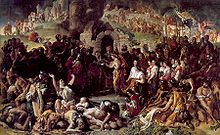Aoife MacMurrough
This article includes a list of general references, but it lacks sufficient corresponding inline citations. (November 2010) |
Aoife MacMurrough | |
|---|---|
 The Marriage of Strongbow and Eva (1854) by Daniel Maclise, a romanticised depiction of the union between Aoife and Richard de Clare in the ruins of Waterford | |
| Born | 1145 |
| Died | 1188 |
| Noble family | MacMurrough-Kavanagh family |
| Spouse(s) | Richard de Clare, 2nd Earl of Pembroke |
| Father | Dermot MacMurrough |
| Mother | Mor O'Toole |
Aoife MacMurrough (c. 1145 – 1188, Irish: Aoife Ní Diarmait), also known by later historians as Eva of Leinster, was an Irish noble, lady of Leinster and countess of Pembroke. She was the daughter of Dermot MacMurrough (c. 1110 – 1171) (Irish: Diarmait Mac Murchada), King of Leinster, and his wife Mor O'Toole (c. 1114 – 1191).
Life
On the 29 August 1170, following the Norman invasion of Ireland that her father had requested, she married Richard de Clare, 2nd Earl of Pembroke, better known as Strongbow, the leader of the Norman invasion force, in Christchurch cathedral in Waterford. Her father, Dermot MacMurrough, who was seeking a military alliance with Strongbow in his feud with King of Breffney, Tiernan O'Ruark, had promised Aoife to Pembroke. However, according to Brehon law, both the man and the woman had to consent to the marriage, so it is fair to conclude that Aoife accepted her father's arrangements.[1]
Under Anglo-Norman law, this gave Strongbow succession rights to the Kingdom of Leinster. Under Irish Brehon law, the marriage gave her a life interest only, after which any land would normally revert to male cousins; but Brehon law also recognised a transfer of "swordland" following a conquest. Aoife led troops in battle and is sometimes known as Red Eva (Irish: Aoife Rua).[2]
She had two sons and a daughter with her husband Richard de Clare, and via their daughter, Isabel de Clare, within a few generations their descendants included much of the nobility of Europe including all the monarchs of Scotland since Robert I (1274–1329) and all those of England, Great Britain and the United Kingdom since Henry IV (1367–1413); and, apart from Anne of Cleves, all the queen consorts of Henry VIII.[3]
Issue
| Name | Birth | Death | Notes |
|---|---|---|---|
| Isabel de Clare, 4th Countess of Pembroke | 1172 | 1220 | m. Aug 1189, Sir William Marshal, 1st Earl of Pembroke, Lord Marshal, son of John Fitz Gilbert, Marshal (Marechal) of England, and Sibylla of Salisbury. |
| Gilbert de Striguil (Chepstow), 3rd Earl of Pembroke | 1173 | 1185 | Inherited title from father but died as a minor. The title then went to his sister's husband on marriage. Isabel's husband, William Marshal, was given the title Earl of Pembroke in his own right by King John of England. Until that time, Marshal did not call himself the Earl until he had achieved the privilege in his own right, rather than through his marriage to Isabel. |
See also
References
- ^ Hull, Eleanor (1931). A History of Ireland and Her People. Retrieved 12 Aug 2016.
- ^ Igoe, Brian (2013). The Story of Ireland. Google Books. p. 35. Retrieved 12 Aug 2016.
- ^ Lundy, Darryl. "Robert I Bruce, King of Scotland". The Peerage. Retrieved 12 Aug 2016.
Sources
- O Croinin, Daibhi (1995) Early Medieval Ireland 400-1200 London: Longman Press; p. 281
- Salmonson, Jessica Amanda.(1991) The Encyclopedia of Amazons. Paragon House. Page 160. ISBN 1-55778-420-5
- Weis, Frederick Lewis Ancestral Roots of Certain American Colonists Who Came to America Before 1700, Lines: 66-26, 175-7, 261-30
